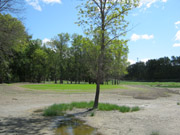
By Myron Love
IT was looking to be a positive year for the municipally-owned Wheat City Golf Course in Brandon, Man.
“We thought we would just need to do a little massaging here and there,” says Tim Benstead, the golf course’s superintendent.
Then the deluge came.
This past spring, southwestern Manitoba experienced its worst flooding in centuries as all the rivers in the region flooded their banks. Most golf courses experienced flooding, with Wheat City—on the bank of the Assiniboine River—among the worst hit.
Wheat City Golf Course is located in north Brandon—located 200 kilometres west of Winnipeg on the TransCanada Highway—Manitoba’s second largest city. The course began as a nine-hole layout in the late 1950s and began as an 18-hole course in 1962. The club had 375 members last year.
The problems began for Wheat City with an ice jam in March that pushed Assiniboine’s waters onto some of the greens and fairways—but just for a day or two. Then, on April 17, the water began pouring over the dikes which had been built to protect the course from flooding. Before the waters from the first flood subsided, heavy rains forced even more Assiniboine River water onto the course.
“The dikes were built in 1995 after flooding that year,” says Benstead, who has had previous experience dealing with course flooding in 1995 and 1997 while he was superintendent at the Minnedosa Golf Course. “At that time, $500,000 was spent on the cleanup and rebuilding 11 greens and some tee boxes.”
Benstead reports that 12 of Wheat City’s greens were under 10 feet of water at the peak of the flooding with levels in some low-lying areas measuring up to 40 feet.
“We had two different types of high water,” he said. “The first wave was relatively clean. The second was rusty-coloured—like sewage water—and left a layer of silt over part of the course.”
The flood waters also took out the course’s pumphouse, lift station and irrigation capacity.
Benstead reported that he and his crew were able to begin pumping water off the course on June 28 and completed the process on July 15.
“We had 12 holes under water,” he said. “We have modified nine holes on higher ground that can be played.”
Benstead was pleasantly surprised to see that most of the tees and greens were still in good shape after three months under water. He attributes that to the application of Instrata fungicide to the tees and greens last fall.
“We have been hand watering the greens (that remained above water) since March with a truck,” Benstead noted. The catch is that the course has to share the 3,000-gallon tanker with the City of Brandon. “We get the tanker from 4 p.m. until 8 a.m. the next morning.”
And while the long period of hot, dry weather through July and August has helped dry out the lower areas of the course, the temperatures have dessicated the upper reaches, resulting in many weeds.
Dealing with the one-quarter to one-half-inch of silt covering presents a challenge on its own. It would be too expensive to dig it up and cart it off. Benstead shows where his crew has been using verticutters to cut grooves in the silt to allow the grass to come through.
“We are having the silt tested for nutrients,” he said. “We have a good IPM program, but a lot of this is most likely from farmers’ fields. We don’t know what is in it yet.”
Benstead said that his plan is to build up the lower level fairways and greens, swale some of the roughs to hold water and direct future flood waters to new holding areas and drainage ditches. Because Wheat City Golf Course is municipally-owned, Benstead said, he has a limited budget to work with.
“We had been allocated $100,000 for new greens and a new putting green,” he said. “We can use that money to build up our fairways.
“We are also hoping to receive some compensation from the provincial Department of Disaster Assistance.”
Benstead is hopeful that the dry weather will continue well into the fall so that he and his crew can get the irrigation system up and running again and build up the holes that need building up in order to have the course ready for play next spring.
Print this page